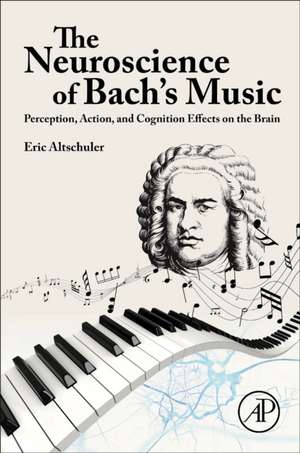The Neuroscience of Bach’s Music: Perception, Action, and Cognition Effects on the Brain
Autor Eric Altschuleren Limba Engleză Paperback – 8 feb 2024
The book is structured to discuss the brain’s action, perception, and cognition as connected to specific Bach concertos, tones, notes, and performances. Two guest contributors provide insight into exact mathematical, or topologic, and music theoretic aspects of Bach’s music with implications for cognitive neuroscience.
- Links specific features and unique characteristics of Bach’s music to perceptual and cognitive neuroscience processes
- Requires only an interest in music or basic music training
- Accompanied by a companion website with music examples mentioned in the book
Preț: 670.85 lei
Preț vechi: 877.94 lei
-24% Nou
Puncte Express: 1006
Preț estimativ în valută:
128.37€ • 137.27$ • 107.03£
128.37€ • 137.27$ • 107.03£
Carte tipărită la comandă
Livrare economică 11-25 aprilie
Preluare comenzi: 021 569.72.76
Specificații
ISBN-13: 9780443135194
ISBN-10: 0443135193
Pagini: 370
Dimensiuni: 152 x 229 x 22 mm
Greutate: 0.5 kg
Editura: ELSEVIER SCIENCE
ISBN-10: 0443135193
Pagini: 370
Dimensiuni: 152 x 229 x 22 mm
Greutate: 0.5 kg
Editura: ELSEVIER SCIENCE
Cuprins
Section 1: Prelude
1. Introduction
2. Background and Overview of Johann Sebastian Bach
3. Basics of the Brain and Perception
Section 2: Playing Bach and the Brain – Action
4. Playing Bach’s Suites for Solo Cello and Experiencing One’s Actions without Perception and Clocking Libet’s “Mind Time
5. Neural Performance, Action Requirements, and Challenges of Playing Bach’s Concerto for Two Violins – A Study of Synchronization and Perceptual Experience
6. Adding a Third Violin to Bach’s Brandenburg Concerto No. 6 – Challenges in Synchronization and Listener Experience
7. More than Three – Perceptual, Action, and Cognitive Challenges for Performers and Listeners
8. Virtuoso of Bach’s Composing and Performance Expectations
Section 3: Listening to Bach – Perception of Musical Space and Landscape
9. The Neuroscience of “Affekt – Music, Emotions, and the Brain’s Limbic System
10. “Affekt Related to Tempos and Effects – Bach’s Composition and Emotional Playing
11. The Algebra of Bach’s Transcriptions for Various Instruments and Cognitive Effects
Section 4: Bach and the Exploration of the Tonal System and Beyond – Cognition
12. Parallel Fifths and the Cognitive-Perceptual System
13. Enharmonic Notes Across Instruments in Bach’s Compositions
14. Modal Traces and the Cognitive-Perceptual System
15. Bach’s 12-Tone Row, Cognition, and Musical Perception
16. Present and Future Neuroimaging Studies of Bach
Section 5: Mathematical Bach
17. Topology in Bach I – The Brain’s Analysis of Bach’s Match to a “Möbius Strip Structure
18. Topology in Bach II – The Brain’s Ability to Hear Topologic Structures
19. Unbroken and Broken Symmetry in Bach’s Compositions
20. The Perceptual Effect of Escher’s “Tiling Time
Section 7: Conclusion
21. Bach and the Brain’s Action, Perception, and Cognition – Summary and Future Applications and Implications Appendix Using Perceptual and Cognitive Approaches to Finding and Using Bach’s Tempos
1. Introduction
2. Background and Overview of Johann Sebastian Bach
3. Basics of the Brain and Perception
Section 2: Playing Bach and the Brain – Action
4. Playing Bach’s Suites for Solo Cello and Experiencing One’s Actions without Perception and Clocking Libet’s “Mind Time
5. Neural Performance, Action Requirements, and Challenges of Playing Bach’s Concerto for Two Violins – A Study of Synchronization and Perceptual Experience
6. Adding a Third Violin to Bach’s Brandenburg Concerto No. 6 – Challenges in Synchronization and Listener Experience
7. More than Three – Perceptual, Action, and Cognitive Challenges for Performers and Listeners
8. Virtuoso of Bach’s Composing and Performance Expectations
Section 3: Listening to Bach – Perception of Musical Space and Landscape
9. The Neuroscience of “Affekt – Music, Emotions, and the Brain’s Limbic System
10. “Affekt Related to Tempos and Effects – Bach’s Composition and Emotional Playing
11. The Algebra of Bach’s Transcriptions for Various Instruments and Cognitive Effects
Section 4: Bach and the Exploration of the Tonal System and Beyond – Cognition
12. Parallel Fifths and the Cognitive-Perceptual System
13. Enharmonic Notes Across Instruments in Bach’s Compositions
14. Modal Traces and the Cognitive-Perceptual System
15. Bach’s 12-Tone Row, Cognition, and Musical Perception
16. Present and Future Neuroimaging Studies of Bach
Section 5: Mathematical Bach
17. Topology in Bach I – The Brain’s Analysis of Bach’s Match to a “Möbius Strip Structure
18. Topology in Bach II – The Brain’s Ability to Hear Topologic Structures
19. Unbroken and Broken Symmetry in Bach’s Compositions
20. The Perceptual Effect of Escher’s “Tiling Time
Section 7: Conclusion
21. Bach and the Brain’s Action, Perception, and Cognition – Summary and Future Applications and Implications Appendix Using Perceptual and Cognitive Approaches to Finding and Using Bach’s Tempos
Recenzii
"Altschuler’s pioneering study — illustrated with numerous musical examples — aims to show how Bach-centred neuroscience “can help us better appreciate perceptual and cognitive affects in Bach and create better performances of the composer’s work. It also teaches us how music perception is not localized to one region of the brain but occurs throughout it, and varies from person to person." --Andrew Robinson, Nature
